Management and Leadership Challenges & Practices at Marks and Spencer
VerifiedAdded on 2020/10/23
|11
|3380
|120
Report
AI Summary
This report provides an in-depth analysis of leadership styles within the context of Marks and Spencer (M&S). It explores the application of various leadership approaches, including autocratic, situational, strategic, coaching, and team leadership, and assesses their impact on team performance and overall organizational success. The report examines how different leadership styles are suited to various situations and their effectiveness in achieving business goals. Furthermore, it discusses the role of leaders in establishing a culture of professionalism, trust, and mutual respect within teams, as well as the importance of ethical and value-based leadership approaches. The analysis considers how these factors influence employee motivation, performance, and the achievement of organizational objectives. The report highlights the significance of strategic decision-making, employee development, and fostering a supportive work environment to drive business growth and maintain a positive brand image.
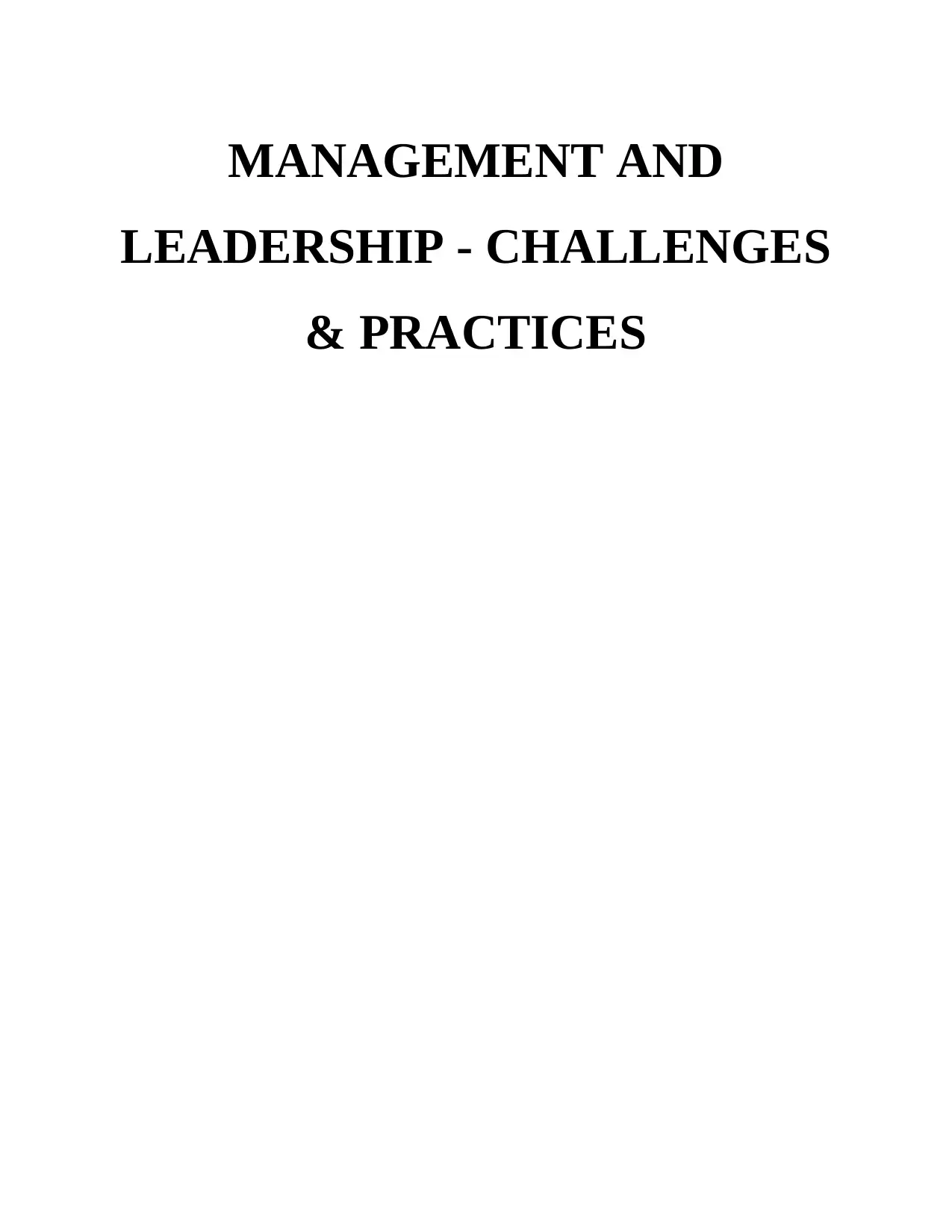
MANAGEMENT AND
LEADERSHIP - CHALLENGES
& PRACTICES
LEADERSHIP - CHALLENGES
& PRACTICES
Paraphrase This Document
Need a fresh take? Get an instant paraphrase of this document with our AI Paraphraser
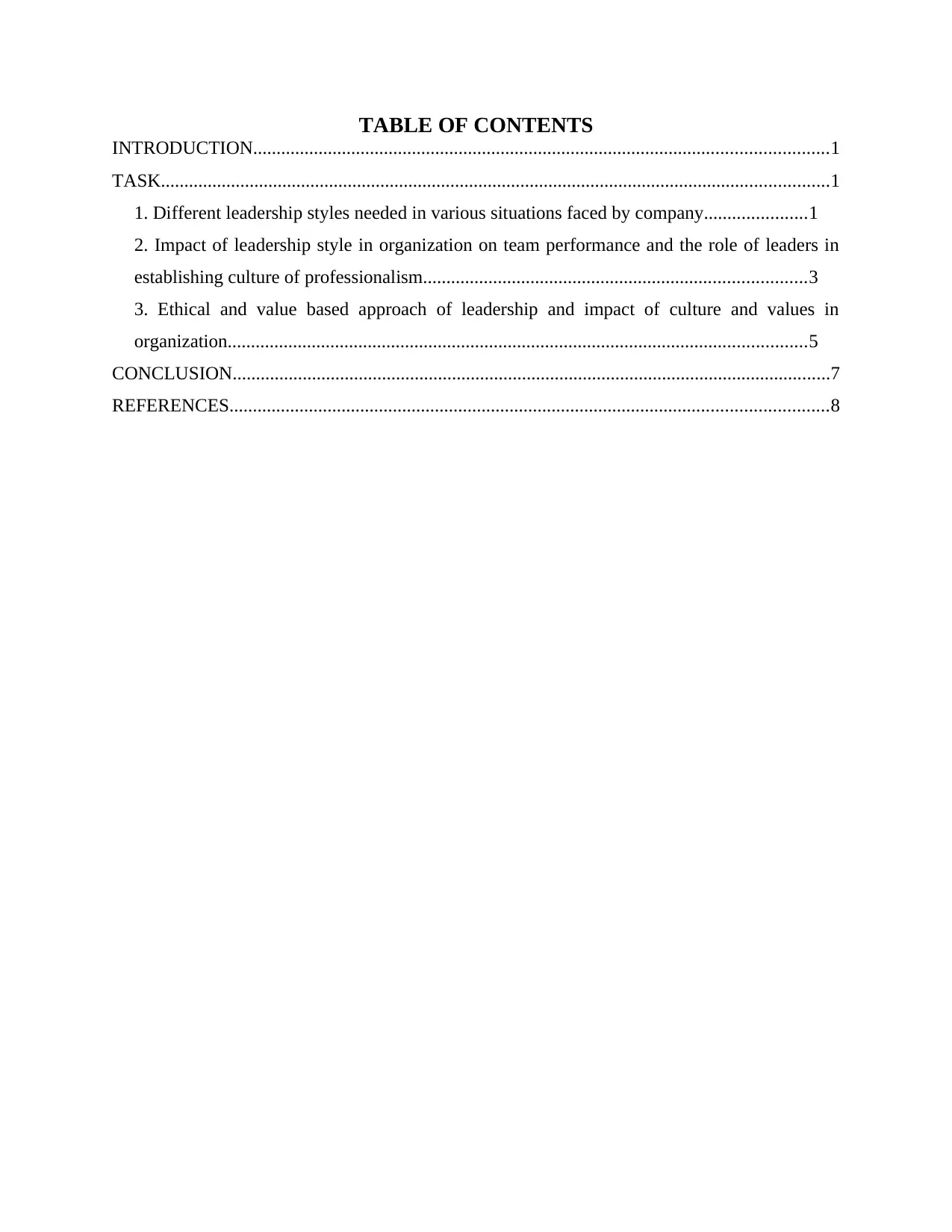
TABLE OF CONTENTS
INTRODUCTION...........................................................................................................................1
TASK...............................................................................................................................................1
1. Different leadership styles needed in various situations faced by company......................1
2. Impact of leadership style in organization on team performance and the role of leaders in
establishing culture of professionalism..................................................................................3
3. Ethical and value based approach of leadership and impact of culture and values in
organization............................................................................................................................5
CONCLUSION................................................................................................................................7
REFERENCES................................................................................................................................8
INTRODUCTION...........................................................................................................................1
TASK...............................................................................................................................................1
1. Different leadership styles needed in various situations faced by company......................1
2. Impact of leadership style in organization on team performance and the role of leaders in
establishing culture of professionalism..................................................................................3
3. Ethical and value based approach of leadership and impact of culture and values in
organization............................................................................................................................5
CONCLUSION................................................................................................................................7
REFERENCES................................................................................................................................8
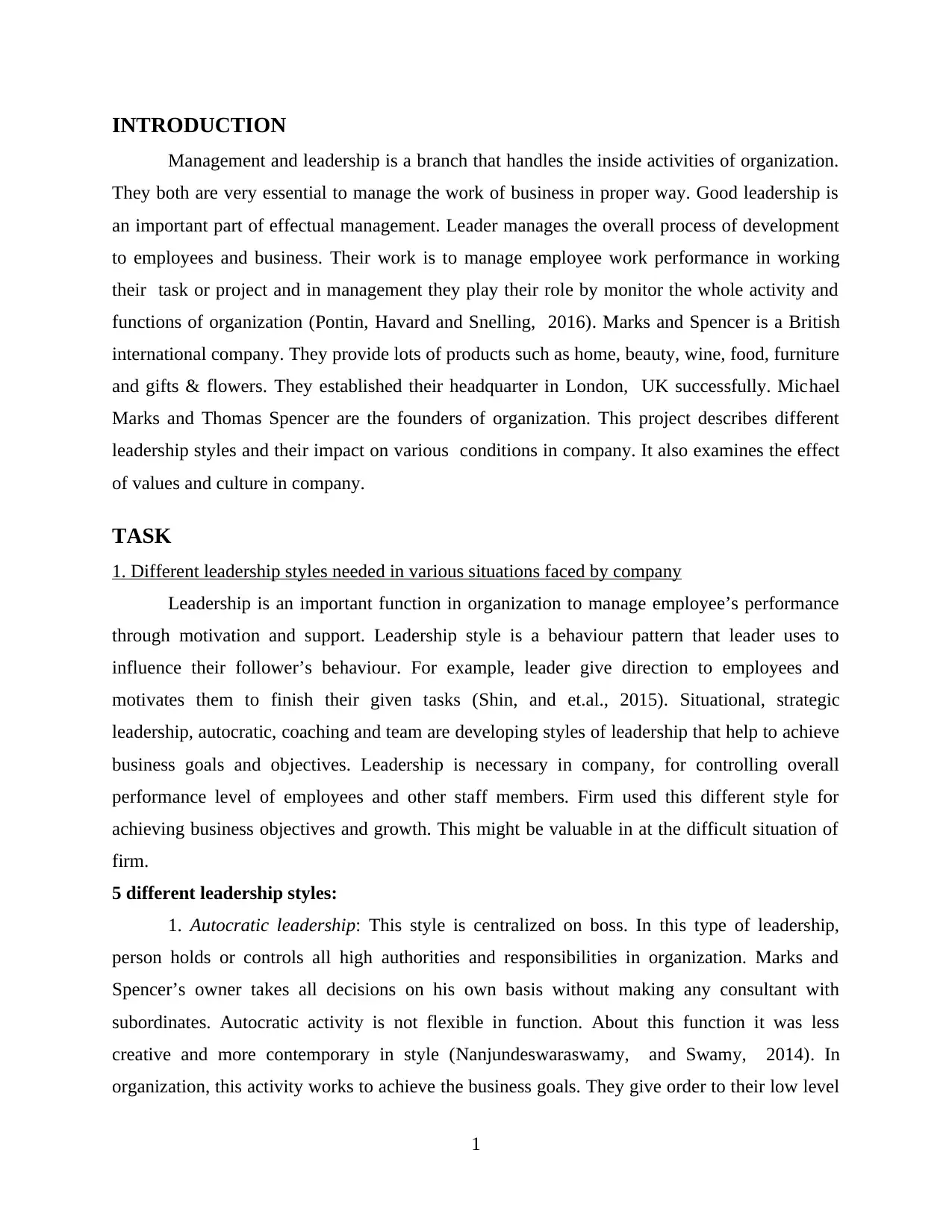
INTRODUCTION
Management and leadership is a branch that handles the inside activities of organization.
They both are very essential to manage the work of business in proper way. Good leadership is
an important part of effectual management. Leader manages the overall process of development
to employees and business. Their work is to manage employee work performance in working
their task or project and in management they play their role by monitor the whole activity and
functions of organization (Pontin, Havard and Snelling, 2016). Marks and Spencer is a British
international company. They provide lots of products such as home, beauty, wine, food, furniture
and gifts & flowers. They established their headquarter in London, UK successfully. Michael
Marks and Thomas Spencer are the founders of organization. This project describes different
leadership styles and their impact on various conditions in company. It also examines the effect
of values and culture in company.
TASK
1. Different leadership styles needed in various situations faced by company
Leadership is an important function in organization to manage employee’s performance
through motivation and support. Leadership style is a behaviour pattern that leader uses to
influence their follower’s behaviour. For example, leader give direction to employees and
motivates them to finish their given tasks (Shin, and et.al., 2015). Situational, strategic
leadership, autocratic, coaching and team are developing styles of leadership that help to achieve
business goals and objectives. Leadership is necessary in company, for controlling overall
performance level of employees and other staff members. Firm used this different style for
achieving business objectives and growth. This might be valuable in at the difficult situation of
firm.
5 different leadership styles:
1. Autocratic leadership: This style is centralized on boss. In this type of leadership,
person holds or controls all high authorities and responsibilities in organization. Marks and
Spencer’s owner takes all decisions on his own basis without making any consultant with
subordinates. Autocratic activity is not flexible in function. About this function it was less
creative and more contemporary in style (Nanjundeswaraswamy, and Swamy, 2014). In
organization, this activity works to achieve the business goals. They give order to their low level
1
Management and leadership is a branch that handles the inside activities of organization.
They both are very essential to manage the work of business in proper way. Good leadership is
an important part of effectual management. Leader manages the overall process of development
to employees and business. Their work is to manage employee work performance in working
their task or project and in management they play their role by monitor the whole activity and
functions of organization (Pontin, Havard and Snelling, 2016). Marks and Spencer is a British
international company. They provide lots of products such as home, beauty, wine, food, furniture
and gifts & flowers. They established their headquarter in London, UK successfully. Michael
Marks and Thomas Spencer are the founders of organization. This project describes different
leadership styles and their impact on various conditions in company. It also examines the effect
of values and culture in company.
TASK
1. Different leadership styles needed in various situations faced by company
Leadership is an important function in organization to manage employee’s performance
through motivation and support. Leadership style is a behaviour pattern that leader uses to
influence their follower’s behaviour. For example, leader give direction to employees and
motivates them to finish their given tasks (Shin, and et.al., 2015). Situational, strategic
leadership, autocratic, coaching and team are developing styles of leadership that help to achieve
business goals and objectives. Leadership is necessary in company, for controlling overall
performance level of employees and other staff members. Firm used this different style for
achieving business objectives and growth. This might be valuable in at the difficult situation of
firm.
5 different leadership styles:
1. Autocratic leadership: This style is centralized on boss. In this type of leadership,
person holds or controls all high authorities and responsibilities in organization. Marks and
Spencer’s owner takes all decisions on his own basis without making any consultant with
subordinates. Autocratic activity is not flexible in function. About this function it was less
creative and more contemporary in style (Nanjundeswaraswamy, and Swamy, 2014). In
organization, this activity works to achieve the business goals. They give order to their low level
1
⊘ This is a preview!⊘
Do you want full access?
Subscribe today to unlock all pages.

Trusted by 1+ million students worldwide
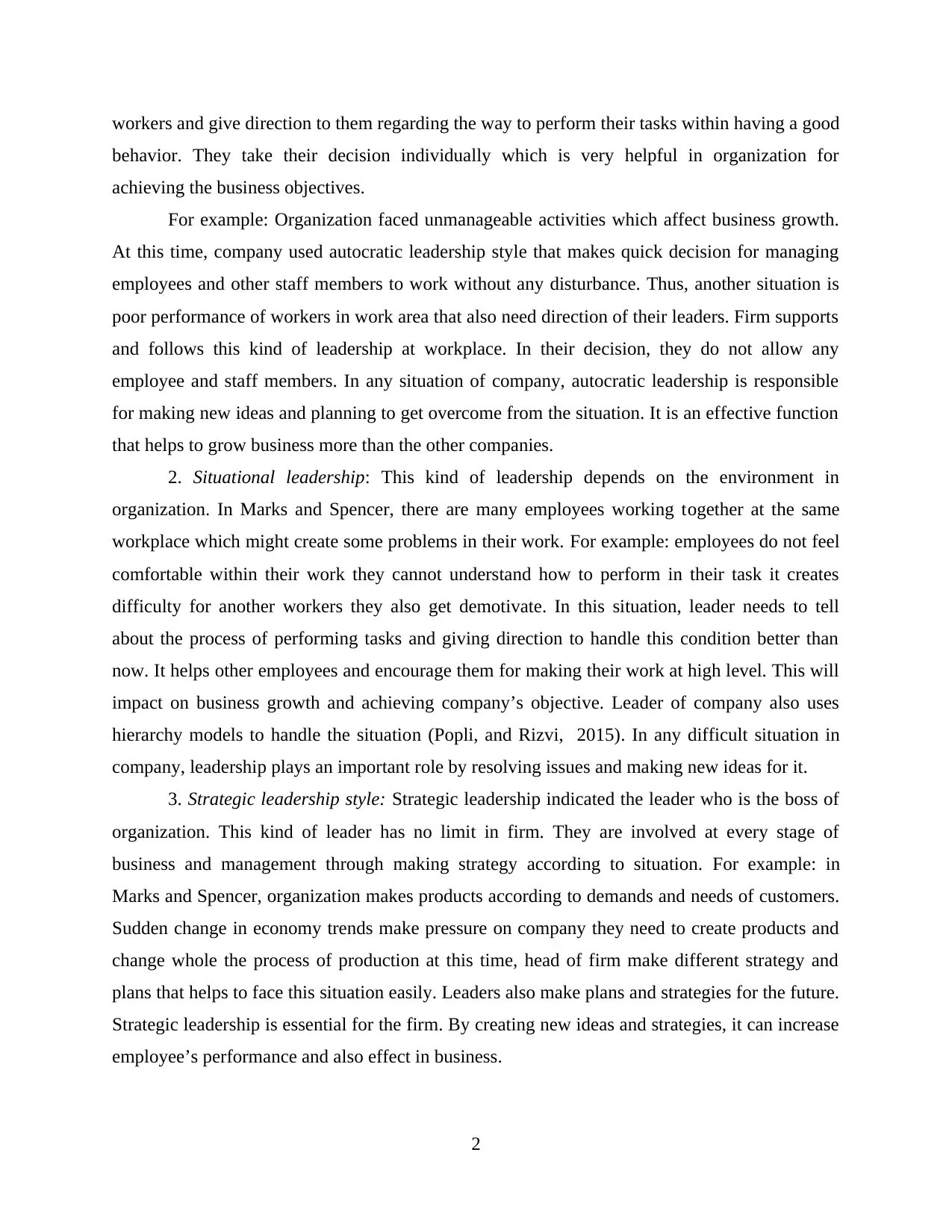
workers and give direction to them regarding the way to perform their tasks within having a good
behavior. They take their decision individually which is very helpful in organization for
achieving the business objectives.
For example: Organization faced unmanageable activities which affect business growth.
At this time, company used autocratic leadership style that makes quick decision for managing
employees and other staff members to work without any disturbance. Thus, another situation is
poor performance of workers in work area that also need direction of their leaders. Firm supports
and follows this kind of leadership at workplace. In their decision, they do not allow any
employee and staff members. In any situation of company, autocratic leadership is responsible
for making new ideas and planning to get overcome from the situation. It is an effective function
that helps to grow business more than the other companies.
2. Situational leadership: This kind of leadership depends on the environment in
organization. In Marks and Spencer, there are many employees working together at the same
workplace which might create some problems in their work. For example: employees do not feel
comfortable within their work they cannot understand how to perform in their task it creates
difficulty for another workers they also get demotivate. In this situation, leader needs to tell
about the process of performing tasks and giving direction to handle this condition better than
now. It helps other employees and encourage them for making their work at high level. This will
impact on business growth and achieving company’s objective. Leader of company also uses
hierarchy models to handle the situation (Popli, and Rizvi, 2015). In any difficult situation in
company, leadership plays an important role by resolving issues and making new ideas for it.
3. Strategic leadership style: Strategic leadership indicated the leader who is the boss of
organization. This kind of leader has no limit in firm. They are involved at every stage of
business and management through making strategy according to situation. For example: in
Marks and Spencer, organization makes products according to demands and needs of customers.
Sudden change in economy trends make pressure on company they need to create products and
change whole the process of production at this time, head of firm make different strategy and
plans that helps to face this situation easily. Leaders also make plans and strategies for the future.
Strategic leadership is essential for the firm. By creating new ideas and strategies, it can increase
employee’s performance and also effect in business.
2
behavior. They take their decision individually which is very helpful in organization for
achieving the business objectives.
For example: Organization faced unmanageable activities which affect business growth.
At this time, company used autocratic leadership style that makes quick decision for managing
employees and other staff members to work without any disturbance. Thus, another situation is
poor performance of workers in work area that also need direction of their leaders. Firm supports
and follows this kind of leadership at workplace. In their decision, they do not allow any
employee and staff members. In any situation of company, autocratic leadership is responsible
for making new ideas and planning to get overcome from the situation. It is an effective function
that helps to grow business more than the other companies.
2. Situational leadership: This kind of leadership depends on the environment in
organization. In Marks and Spencer, there are many employees working together at the same
workplace which might create some problems in their work. For example: employees do not feel
comfortable within their work they cannot understand how to perform in their task it creates
difficulty for another workers they also get demotivate. In this situation, leader needs to tell
about the process of performing tasks and giving direction to handle this condition better than
now. It helps other employees and encourage them for making their work at high level. This will
impact on business growth and achieving company’s objective. Leader of company also uses
hierarchy models to handle the situation (Popli, and Rizvi, 2015). In any difficult situation in
company, leadership plays an important role by resolving issues and making new ideas for it.
3. Strategic leadership style: Strategic leadership indicated the leader who is the boss of
organization. This kind of leader has no limit in firm. They are involved at every stage of
business and management through making strategy according to situation. For example: in
Marks and Spencer, organization makes products according to demands and needs of customers.
Sudden change in economy trends make pressure on company they need to create products and
change whole the process of production at this time, head of firm make different strategy and
plans that helps to face this situation easily. Leaders also make plans and strategies for the future.
Strategic leadership is essential for the firm. By creating new ideas and strategies, it can increase
employee’s performance and also effect in business.
2
Paraphrase This Document
Need a fresh take? Get an instant paraphrase of this document with our AI Paraphraser
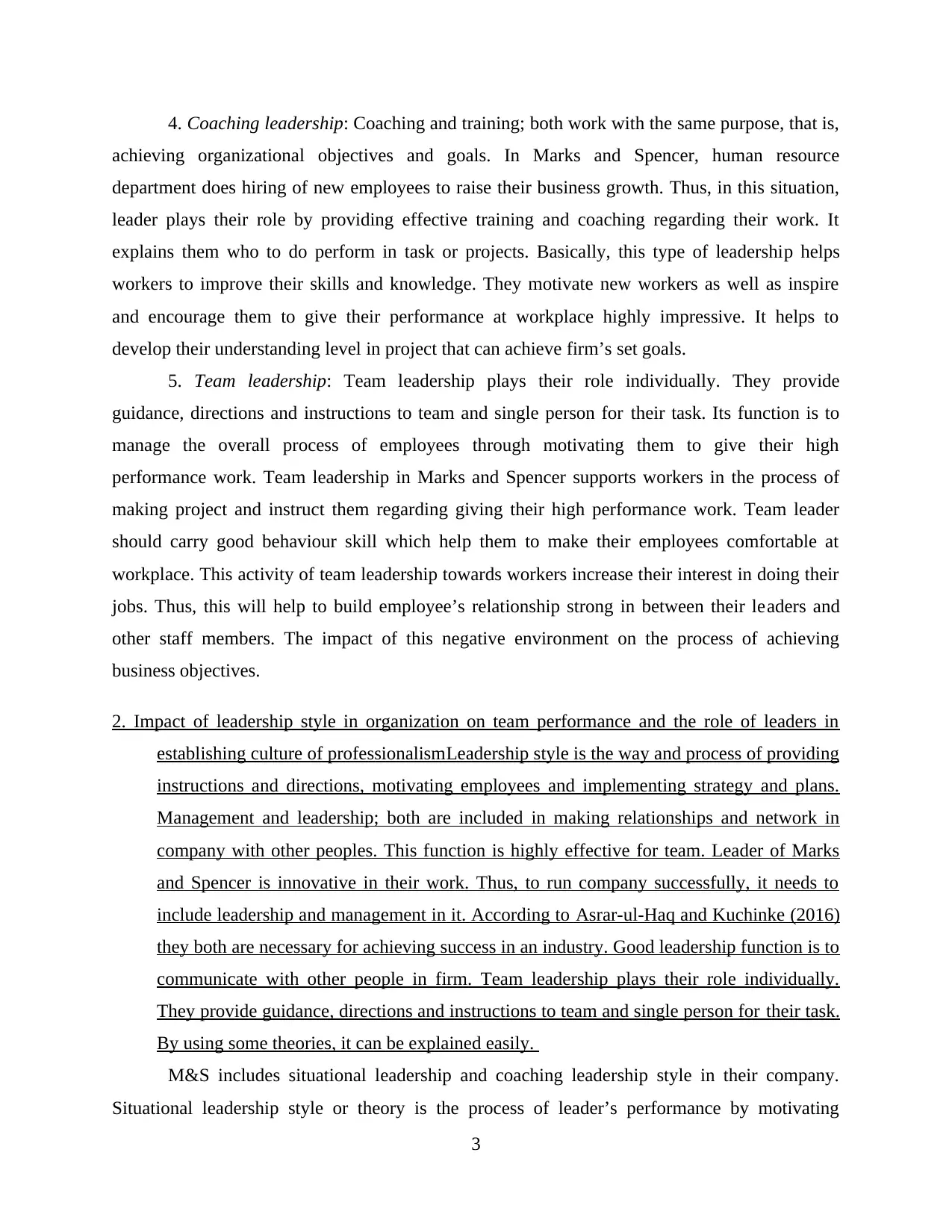
4. Coaching leadership: Coaching and training; both work with the same purpose, that is,
achieving organizational objectives and goals. In Marks and Spencer, human resource
department does hiring of new employees to raise their business growth. Thus, in this situation,
leader plays their role by providing effective training and coaching regarding their work. It
explains them who to do perform in task or projects. Basically, this type of leadership helps
workers to improve their skills and knowledge. They motivate new workers as well as inspire
and encourage them to give their performance at workplace highly impressive. It helps to
develop their understanding level in project that can achieve firm’s set goals.
5. Team leadership: Team leadership plays their role individually. They provide
guidance, directions and instructions to team and single person for their task. Its function is to
manage the overall process of employees through motivating them to give their high
performance work. Team leadership in Marks and Spencer supports workers in the process of
making project and instruct them regarding giving their high performance work. Team leader
should carry good behaviour skill which help them to make their employees comfortable at
workplace. This activity of team leadership towards workers increase their interest in doing their
jobs. Thus, this will help to build employee’s relationship strong in between their leaders and
other staff members. The impact of this negative environment on the process of achieving
business objectives.
2. Impact of leadership style in organization on team performance and the role of leaders in
establishing culture of professionalismLeadership style is the way and process of providing
instructions and directions, motivating employees and implementing strategy and plans.
Management and leadership; both are included in making relationships and network in
company with other peoples. This function is highly effective for team. Leader of Marks
and Spencer is innovative in their work. Thus, to run company successfully, it needs to
include leadership and management in it. According to Asrar-ul-Haq and Kuchinke (2016)
they both are necessary for achieving success in an industry. Good leadership function is to
communicate with other people in firm. Team leadership plays their role individually.
They provide guidance, directions and instructions to team and single person for their task.
By using some theories, it can be explained easily.
M&S includes situational leadership and coaching leadership style in their company.
Situational leadership style or theory is the process of leader’s performance by motivating
3
achieving organizational objectives and goals. In Marks and Spencer, human resource
department does hiring of new employees to raise their business growth. Thus, in this situation,
leader plays their role by providing effective training and coaching regarding their work. It
explains them who to do perform in task or projects. Basically, this type of leadership helps
workers to improve their skills and knowledge. They motivate new workers as well as inspire
and encourage them to give their performance at workplace highly impressive. It helps to
develop their understanding level in project that can achieve firm’s set goals.
5. Team leadership: Team leadership plays their role individually. They provide
guidance, directions and instructions to team and single person for their task. Its function is to
manage the overall process of employees through motivating them to give their high
performance work. Team leadership in Marks and Spencer supports workers in the process of
making project and instruct them regarding giving their high performance work. Team leader
should carry good behaviour skill which help them to make their employees comfortable at
workplace. This activity of team leadership towards workers increase their interest in doing their
jobs. Thus, this will help to build employee’s relationship strong in between their leaders and
other staff members. The impact of this negative environment on the process of achieving
business objectives.
2. Impact of leadership style in organization on team performance and the role of leaders in
establishing culture of professionalismLeadership style is the way and process of providing
instructions and directions, motivating employees and implementing strategy and plans.
Management and leadership; both are included in making relationships and network in
company with other peoples. This function is highly effective for team. Leader of Marks
and Spencer is innovative in their work. Thus, to run company successfully, it needs to
include leadership and management in it. According to Asrar-ul-Haq and Kuchinke (2016)
they both are necessary for achieving success in an industry. Good leadership function is to
communicate with other people in firm. Team leadership plays their role individually.
They provide guidance, directions and instructions to team and single person for their task.
By using some theories, it can be explained easily.
M&S includes situational leadership and coaching leadership style in their company.
Situational leadership style or theory is the process of leader’s performance by motivating
3
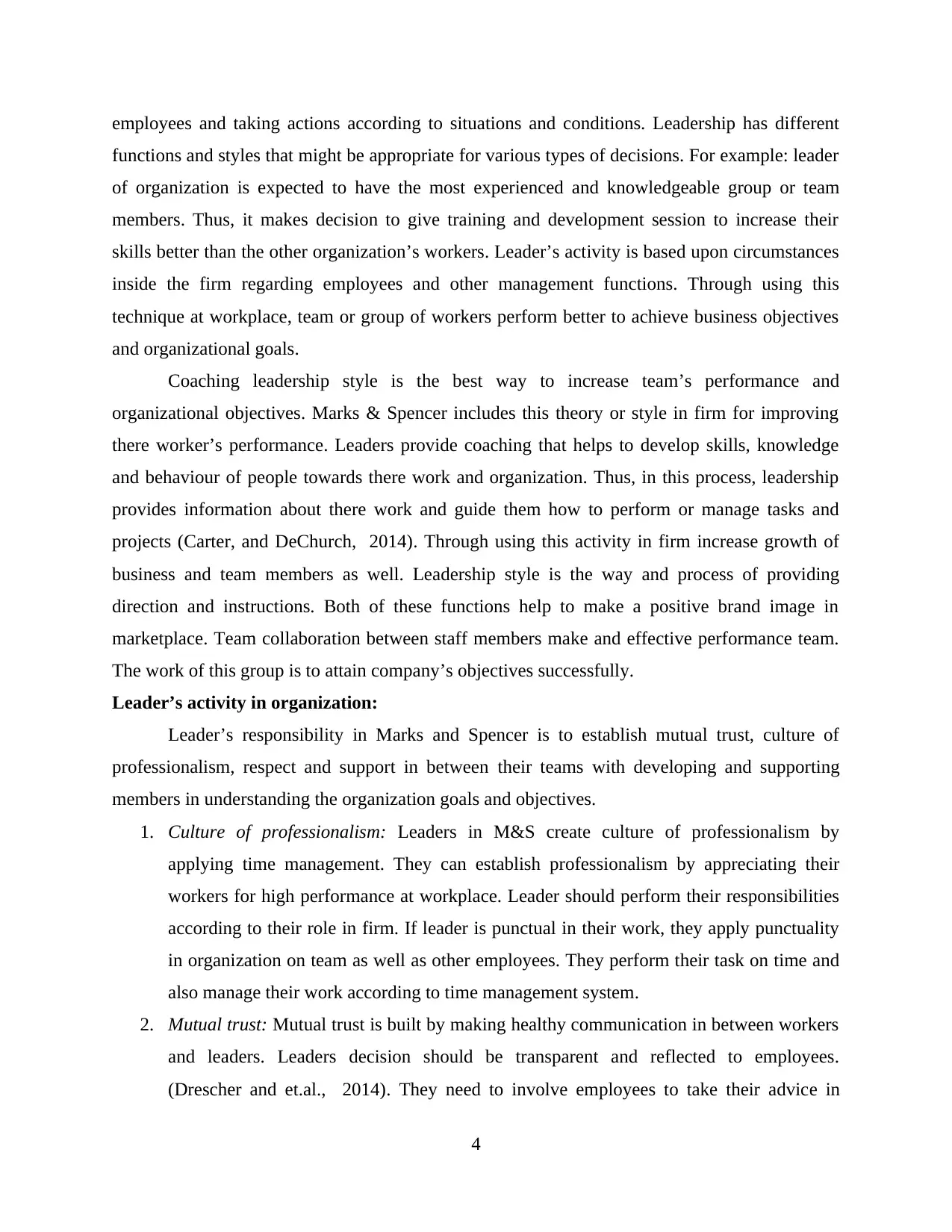
employees and taking actions according to situations and conditions. Leadership has different
functions and styles that might be appropriate for various types of decisions. For example: leader
of organization is expected to have the most experienced and knowledgeable group or team
members. Thus, it makes decision to give training and development session to increase their
skills better than the other organization’s workers. Leader’s activity is based upon circumstances
inside the firm regarding employees and other management functions. Through using this
technique at workplace, team or group of workers perform better to achieve business objectives
and organizational goals.
Coaching leadership style is the best way to increase team’s performance and
organizational objectives. Marks & Spencer includes this theory or style in firm for improving
there worker’s performance. Leaders provide coaching that helps to develop skills, knowledge
and behaviour of people towards there work and organization. Thus, in this process, leadership
provides information about there work and guide them how to perform or manage tasks and
projects (Carter, and DeChurch, 2014). Through using this activity in firm increase growth of
business and team members as well. Leadership style is the way and process of providing
direction and instructions. Both of these functions help to make a positive brand image in
marketplace. Team collaboration between staff members make and effective performance team.
The work of this group is to attain company’s objectives successfully.
Leader’s activity in organization:
Leader’s responsibility in Marks and Spencer is to establish mutual trust, culture of
professionalism, respect and support in between their teams with developing and supporting
members in understanding the organization goals and objectives.
1. Culture of professionalism: Leaders in M&S create culture of professionalism by
applying time management. They can establish professionalism by appreciating their
workers for high performance at workplace. Leader should perform their responsibilities
according to their role in firm. If leader is punctual in their work, they apply punctuality
in organization on team as well as other employees. They perform their task on time and
also manage their work according to time management system.
2. Mutual trust: Mutual trust is built by making healthy communication in between workers
and leaders. Leaders decision should be transparent and reflected to employees.
(Drescher and et.al., 2014). They need to involve employees to take their advice in
4
functions and styles that might be appropriate for various types of decisions. For example: leader
of organization is expected to have the most experienced and knowledgeable group or team
members. Thus, it makes decision to give training and development session to increase their
skills better than the other organization’s workers. Leader’s activity is based upon circumstances
inside the firm regarding employees and other management functions. Through using this
technique at workplace, team or group of workers perform better to achieve business objectives
and organizational goals.
Coaching leadership style is the best way to increase team’s performance and
organizational objectives. Marks & Spencer includes this theory or style in firm for improving
there worker’s performance. Leaders provide coaching that helps to develop skills, knowledge
and behaviour of people towards there work and organization. Thus, in this process, leadership
provides information about there work and guide them how to perform or manage tasks and
projects (Carter, and DeChurch, 2014). Through using this activity in firm increase growth of
business and team members as well. Leadership style is the way and process of providing
direction and instructions. Both of these functions help to make a positive brand image in
marketplace. Team collaboration between staff members make and effective performance team.
The work of this group is to attain company’s objectives successfully.
Leader’s activity in organization:
Leader’s responsibility in Marks and Spencer is to establish mutual trust, culture of
professionalism, respect and support in between their teams with developing and supporting
members in understanding the organization goals and objectives.
1. Culture of professionalism: Leaders in M&S create culture of professionalism by
applying time management. They can establish professionalism by appreciating their
workers for high performance at workplace. Leader should perform their responsibilities
according to their role in firm. If leader is punctual in their work, they apply punctuality
in organization on team as well as other employees. They perform their task on time and
also manage their work according to time management system.
2. Mutual trust: Mutual trust is built by making healthy communication in between workers
and leaders. Leaders decision should be transparent and reflected to employees.
(Drescher and et.al., 2014). They need to involve employees to take their advice in
4
⊘ This is a preview!⊘
Do you want full access?
Subscribe today to unlock all pages.

Trusted by 1+ million students worldwide
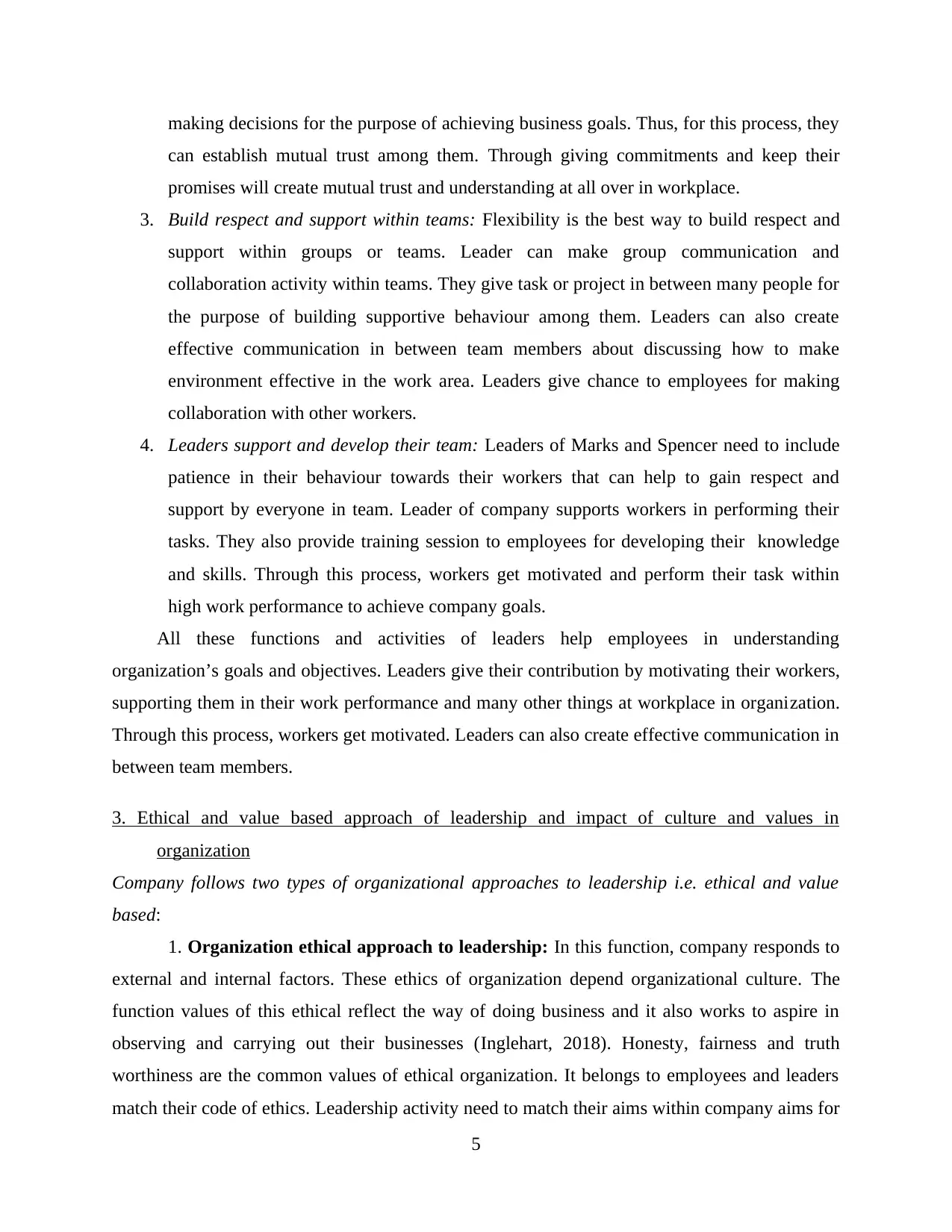
making decisions for the purpose of achieving business goals. Thus, for this process, they
can establish mutual trust among them. Through giving commitments and keep their
promises will create mutual trust and understanding at all over in workplace.
3. Build respect and support within teams: Flexibility is the best way to build respect and
support within groups or teams. Leader can make group communication and
collaboration activity within teams. They give task or project in between many people for
the purpose of building supportive behaviour among them. Leaders can also create
effective communication in between team members about discussing how to make
environment effective in the work area. Leaders give chance to employees for making
collaboration with other workers.
4. Leaders support and develop their team: Leaders of Marks and Spencer need to include
patience in their behaviour towards their workers that can help to gain respect and
support by everyone in team. Leader of company supports workers in performing their
tasks. They also provide training session to employees for developing their knowledge
and skills. Through this process, workers get motivated and perform their task within
high work performance to achieve company goals.
All these functions and activities of leaders help employees in understanding
organization’s goals and objectives. Leaders give their contribution by motivating their workers,
supporting them in their work performance and many other things at workplace in organization.
Through this process, workers get motivated. Leaders can also create effective communication in
between team members.
3. Ethical and value based approach of leadership and impact of culture and values in
organization
Company follows two types of organizational approaches to leadership i.e. ethical and value
based:
1. Organization ethical approach to leadership: In this function, company responds to
external and internal factors. These ethics of organization depend organizational culture. The
function values of this ethical reflect the way of doing business and it also works to aspire in
observing and carrying out their businesses (Inglehart, 2018). Honesty, fairness and truth
worthiness are the common values of ethical organization. It belongs to employees and leaders
match their code of ethics. Leadership activity need to match their aims within company aims for
5
can establish mutual trust among them. Through giving commitments and keep their
promises will create mutual trust and understanding at all over in workplace.
3. Build respect and support within teams: Flexibility is the best way to build respect and
support within groups or teams. Leader can make group communication and
collaboration activity within teams. They give task or project in between many people for
the purpose of building supportive behaviour among them. Leaders can also create
effective communication in between team members about discussing how to make
environment effective in the work area. Leaders give chance to employees for making
collaboration with other workers.
4. Leaders support and develop their team: Leaders of Marks and Spencer need to include
patience in their behaviour towards their workers that can help to gain respect and
support by everyone in team. Leader of company supports workers in performing their
tasks. They also provide training session to employees for developing their knowledge
and skills. Through this process, workers get motivated and perform their task within
high work performance to achieve company goals.
All these functions and activities of leaders help employees in understanding
organization’s goals and objectives. Leaders give their contribution by motivating their workers,
supporting them in their work performance and many other things at workplace in organization.
Through this process, workers get motivated. Leaders can also create effective communication in
between team members.
3. Ethical and value based approach of leadership and impact of culture and values in
organization
Company follows two types of organizational approaches to leadership i.e. ethical and value
based:
1. Organization ethical approach to leadership: In this function, company responds to
external and internal factors. These ethics of organization depend organizational culture. The
function values of this ethical reflect the way of doing business and it also works to aspire in
observing and carrying out their businesses (Inglehart, 2018). Honesty, fairness and truth
worthiness are the common values of ethical organization. It belongs to employees and leaders
match their code of ethics. Leadership activity need to match their aims within company aims for
5
Paraphrase This Document
Need a fresh take? Get an instant paraphrase of this document with our AI Paraphraser
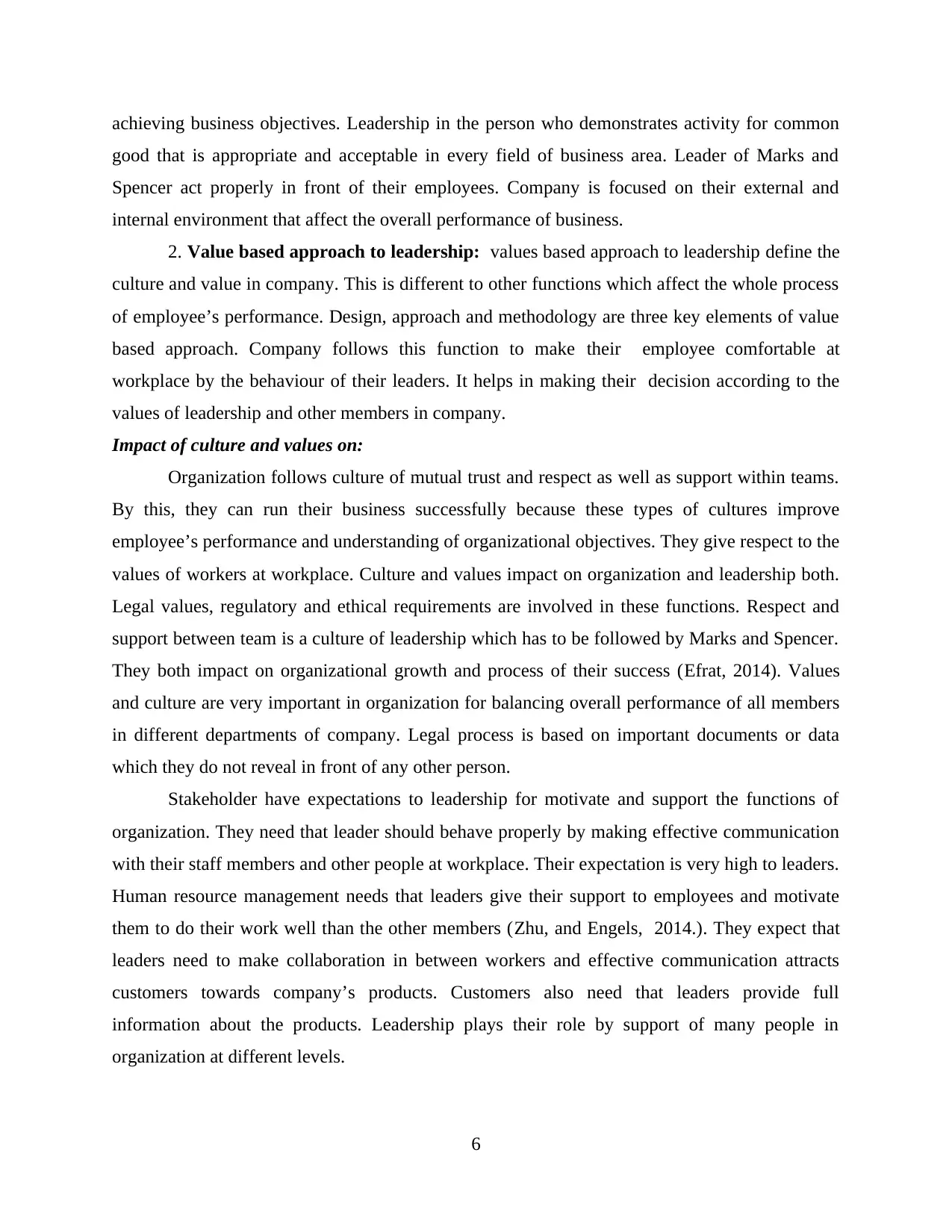
achieving business objectives. Leadership in the person who demonstrates activity for common
good that is appropriate and acceptable in every field of business area. Leader of Marks and
Spencer act properly in front of their employees. Company is focused on their external and
internal environment that affect the overall performance of business.
2. Value based approach to leadership: values based approach to leadership define the
culture and value in company. This is different to other functions which affect the whole process
of employee’s performance. Design, approach and methodology are three key elements of value
based approach. Company follows this function to make their employee comfortable at
workplace by the behaviour of their leaders. It helps in making their decision according to the
values of leadership and other members in company.
Impact of culture and values on:
Organization follows culture of mutual trust and respect as well as support within teams.
By this, they can run their business successfully because these types of cultures improve
employee’s performance and understanding of organizational objectives. They give respect to the
values of workers at workplace. Culture and values impact on organization and leadership both.
Legal values, regulatory and ethical requirements are involved in these functions. Respect and
support between team is a culture of leadership which has to be followed by Marks and Spencer.
They both impact on organizational growth and process of their success (Efrat, 2014). Values
and culture are very important in organization for balancing overall performance of all members
in different departments of company. Legal process is based on important documents or data
which they do not reveal in front of any other person.
Stakeholder have expectations to leadership for motivate and support the functions of
organization. They need that leader should behave properly by making effective communication
with their staff members and other people at workplace. Their expectation is very high to leaders.
Human resource management needs that leaders give their support to employees and motivate
them to do their work well than the other members (Zhu, and Engels, 2014.). They expect that
leaders need to make collaboration in between workers and effective communication attracts
customers towards company’s products. Customers also need that leaders provide full
information about the products. Leadership plays their role by support of many people in
organization at different levels.
6
good that is appropriate and acceptable in every field of business area. Leader of Marks and
Spencer act properly in front of their employees. Company is focused on their external and
internal environment that affect the overall performance of business.
2. Value based approach to leadership: values based approach to leadership define the
culture and value in company. This is different to other functions which affect the whole process
of employee’s performance. Design, approach and methodology are three key elements of value
based approach. Company follows this function to make their employee comfortable at
workplace by the behaviour of their leaders. It helps in making their decision according to the
values of leadership and other members in company.
Impact of culture and values on:
Organization follows culture of mutual trust and respect as well as support within teams.
By this, they can run their business successfully because these types of cultures improve
employee’s performance and understanding of organizational objectives. They give respect to the
values of workers at workplace. Culture and values impact on organization and leadership both.
Legal values, regulatory and ethical requirements are involved in these functions. Respect and
support between team is a culture of leadership which has to be followed by Marks and Spencer.
They both impact on organizational growth and process of their success (Efrat, 2014). Values
and culture are very important in organization for balancing overall performance of all members
in different departments of company. Legal process is based on important documents or data
which they do not reveal in front of any other person.
Stakeholder have expectations to leadership for motivate and support the functions of
organization. They need that leader should behave properly by making effective communication
with their staff members and other people at workplace. Their expectation is very high to leaders.
Human resource management needs that leaders give their support to employees and motivate
them to do their work well than the other members (Zhu, and Engels, 2014.). They expect that
leaders need to make collaboration in between workers and effective communication attracts
customers towards company’s products. Customers also need that leaders provide full
information about the products. Leadership plays their role by support of many people in
organization at different levels.
6
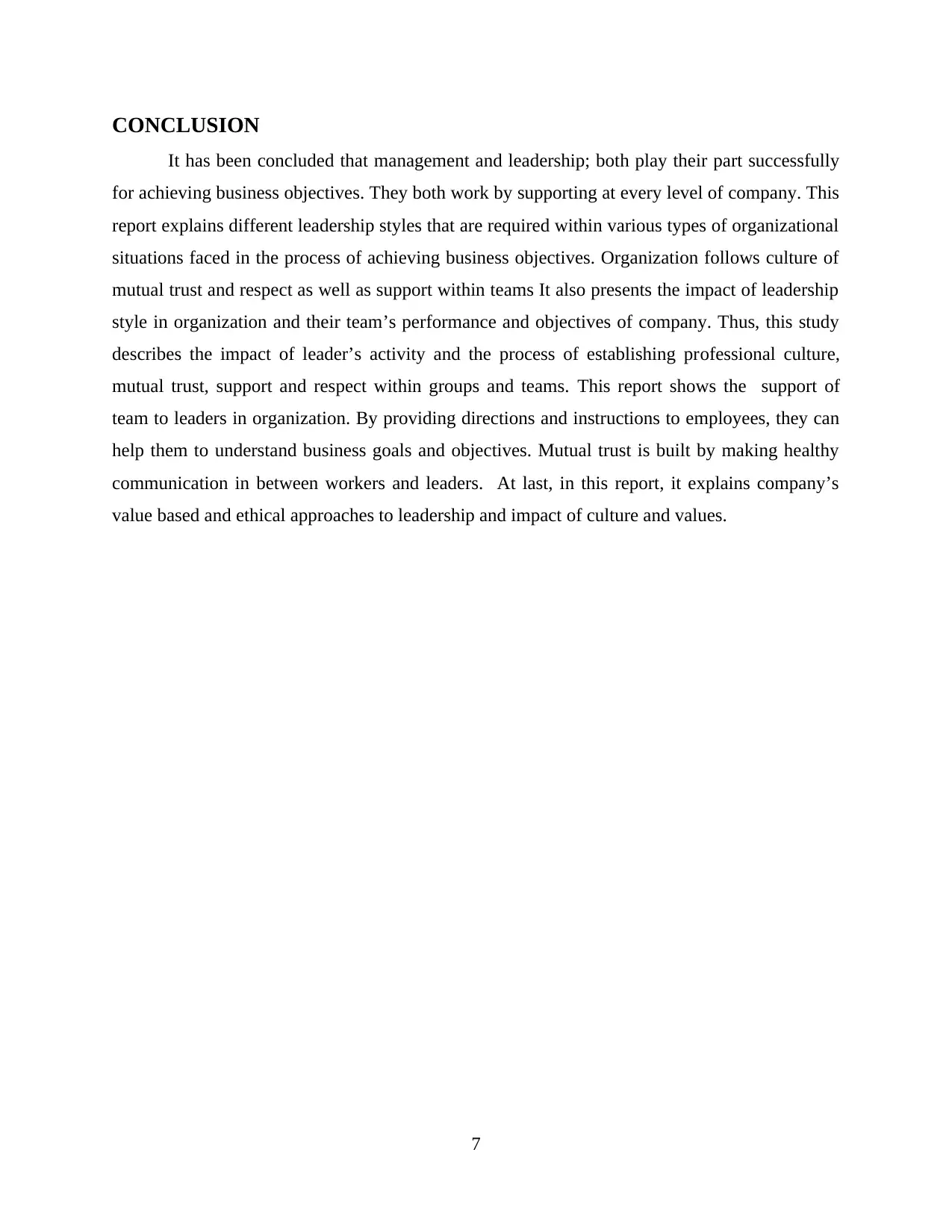
CONCLUSION
It has been concluded that management and leadership; both play their part successfully
for achieving business objectives. They both work by supporting at every level of company. This
report explains different leadership styles that are required within various types of organizational
situations faced in the process of achieving business objectives. Organization follows culture of
mutual trust and respect as well as support within teams It also presents the impact of leadership
style in organization and their team’s performance and objectives of company. Thus, this study
describes the impact of leader’s activity and the process of establishing professional culture,
mutual trust, support and respect within groups and teams. This report shows the support of
team to leaders in organization. By providing directions and instructions to employees, they can
help them to understand business goals and objectives. Mutual trust is built by making healthy
communication in between workers and leaders. At last, in this report, it explains company’s
value based and ethical approaches to leadership and impact of culture and values.
7
It has been concluded that management and leadership; both play their part successfully
for achieving business objectives. They both work by supporting at every level of company. This
report explains different leadership styles that are required within various types of organizational
situations faced in the process of achieving business objectives. Organization follows culture of
mutual trust and respect as well as support within teams It also presents the impact of leadership
style in organization and their team’s performance and objectives of company. Thus, this study
describes the impact of leader’s activity and the process of establishing professional culture,
mutual trust, support and respect within groups and teams. This report shows the support of
team to leaders in organization. By providing directions and instructions to employees, they can
help them to understand business goals and objectives. Mutual trust is built by making healthy
communication in between workers and leaders. At last, in this report, it explains company’s
value based and ethical approaches to leadership and impact of culture and values.
7
⊘ This is a preview!⊘
Do you want full access?
Subscribe today to unlock all pages.

Trusted by 1+ million students worldwide
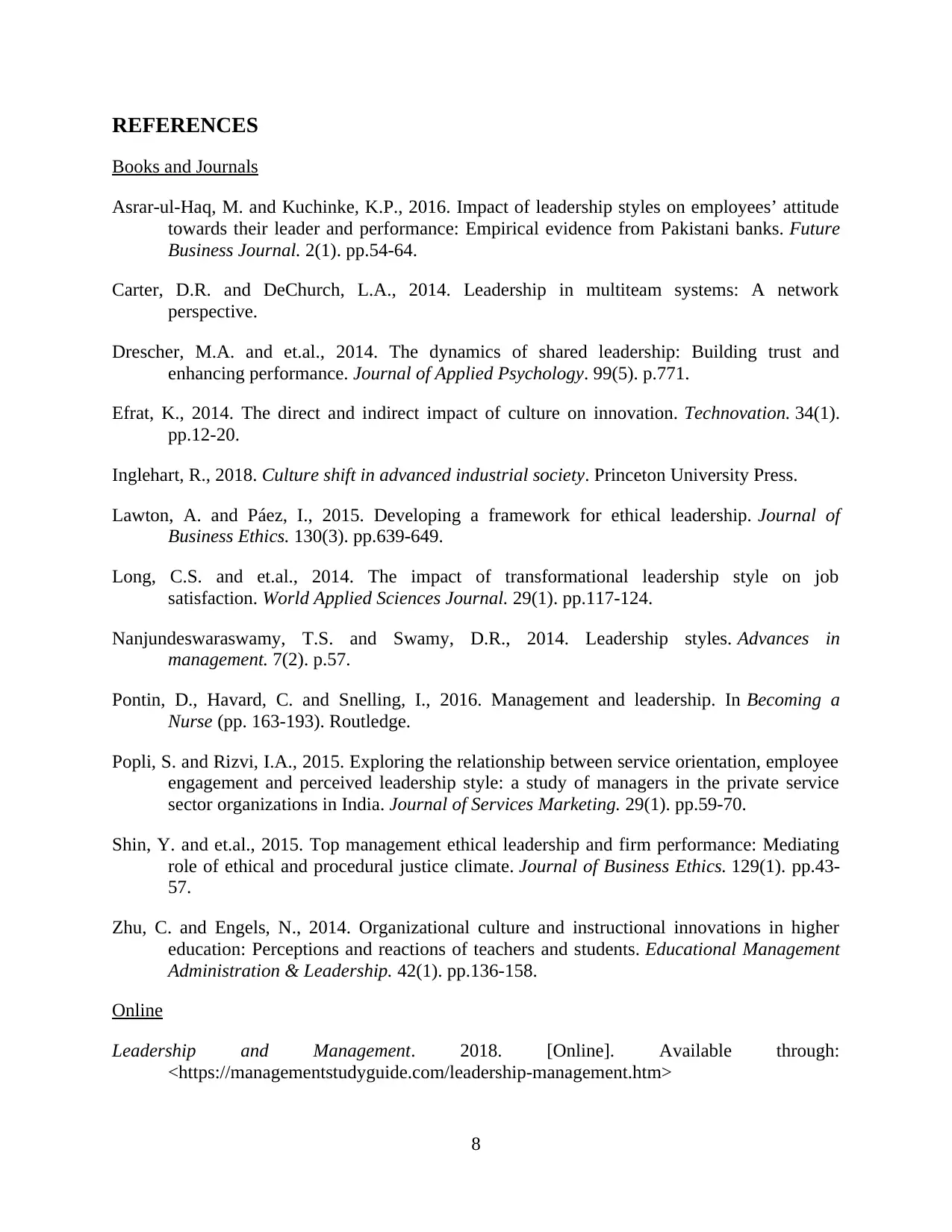
REFERENCES
Books and Journals
Asrar-ul-Haq, M. and Kuchinke, K.P., 2016. Impact of leadership styles on employees’ attitude
towards their leader and performance: Empirical evidence from Pakistani banks. Future
Business Journal. 2(1). pp.54-64.
Carter, D.R. and DeChurch, L.A., 2014. Leadership in multiteam systems: A network
perspective.
Drescher, M.A. and et.al., 2014. The dynamics of shared leadership: Building trust and
enhancing performance. Journal of Applied Psychology. 99(5). p.771.
Efrat, K., 2014. The direct and indirect impact of culture on innovation. Technovation. 34(1).
pp.12-20.
Inglehart, R., 2018. Culture shift in advanced industrial society. Princeton University Press.
Lawton, A. and Páez, I., 2015. Developing a framework for ethical leadership. Journal of
Business Ethics. 130(3). pp.639-649.
Long, C.S. and et.al., 2014. The impact of transformational leadership style on job
satisfaction. World Applied Sciences Journal. 29(1). pp.117-124.
Nanjundeswaraswamy, T.S. and Swamy, D.R., 2014. Leadership styles. Advances in
management. 7(2). p.57.
Pontin, D., Havard, C. and Snelling, I., 2016. Management and leadership. In Becoming a
Nurse (pp. 163-193). Routledge.
Popli, S. and Rizvi, I.A., 2015. Exploring the relationship between service orientation, employee
engagement and perceived leadership style: a study of managers in the private service
sector organizations in India. Journal of Services Marketing. 29(1). pp.59-70.
Shin, Y. and et.al., 2015. Top management ethical leadership and firm performance: Mediating
role of ethical and procedural justice climate. Journal of Business Ethics. 129(1). pp.43-
57.
Zhu, C. and Engels, N., 2014. Organizational culture and instructional innovations in higher
education: Perceptions and reactions of teachers and students. Educational Management
Administration & Leadership. 42(1). pp.136-158.
Online
Leadership and Management. 2018. [Online]. Available through:
<https://managementstudyguide.com/leadership-management.htm>
8
Books and Journals
Asrar-ul-Haq, M. and Kuchinke, K.P., 2016. Impact of leadership styles on employees’ attitude
towards their leader and performance: Empirical evidence from Pakistani banks. Future
Business Journal. 2(1). pp.54-64.
Carter, D.R. and DeChurch, L.A., 2014. Leadership in multiteam systems: A network
perspective.
Drescher, M.A. and et.al., 2014. The dynamics of shared leadership: Building trust and
enhancing performance. Journal of Applied Psychology. 99(5). p.771.
Efrat, K., 2014. The direct and indirect impact of culture on innovation. Technovation. 34(1).
pp.12-20.
Inglehart, R., 2018. Culture shift in advanced industrial society. Princeton University Press.
Lawton, A. and Páez, I., 2015. Developing a framework for ethical leadership. Journal of
Business Ethics. 130(3). pp.639-649.
Long, C.S. and et.al., 2014. The impact of transformational leadership style on job
satisfaction. World Applied Sciences Journal. 29(1). pp.117-124.
Nanjundeswaraswamy, T.S. and Swamy, D.R., 2014. Leadership styles. Advances in
management. 7(2). p.57.
Pontin, D., Havard, C. and Snelling, I., 2016. Management and leadership. In Becoming a
Nurse (pp. 163-193). Routledge.
Popli, S. and Rizvi, I.A., 2015. Exploring the relationship between service orientation, employee
engagement and perceived leadership style: a study of managers in the private service
sector organizations in India. Journal of Services Marketing. 29(1). pp.59-70.
Shin, Y. and et.al., 2015. Top management ethical leadership and firm performance: Mediating
role of ethical and procedural justice climate. Journal of Business Ethics. 129(1). pp.43-
57.
Zhu, C. and Engels, N., 2014. Organizational culture and instructional innovations in higher
education: Perceptions and reactions of teachers and students. Educational Management
Administration & Leadership. 42(1). pp.136-158.
Online
Leadership and Management. 2018. [Online]. Available through:
<https://managementstudyguide.com/leadership-management.htm>
8
Paraphrase This Document
Need a fresh take? Get an instant paraphrase of this document with our AI Paraphraser

9
1 out of 11
Related Documents
Your All-in-One AI-Powered Toolkit for Academic Success.
+13062052269
info@desklib.com
Available 24*7 on WhatsApp / Email
![[object Object]](/_next/static/media/star-bottom.7253800d.svg)
Unlock your academic potential
Copyright © 2020–2025 A2Z Services. All Rights Reserved. Developed and managed by ZUCOL.





